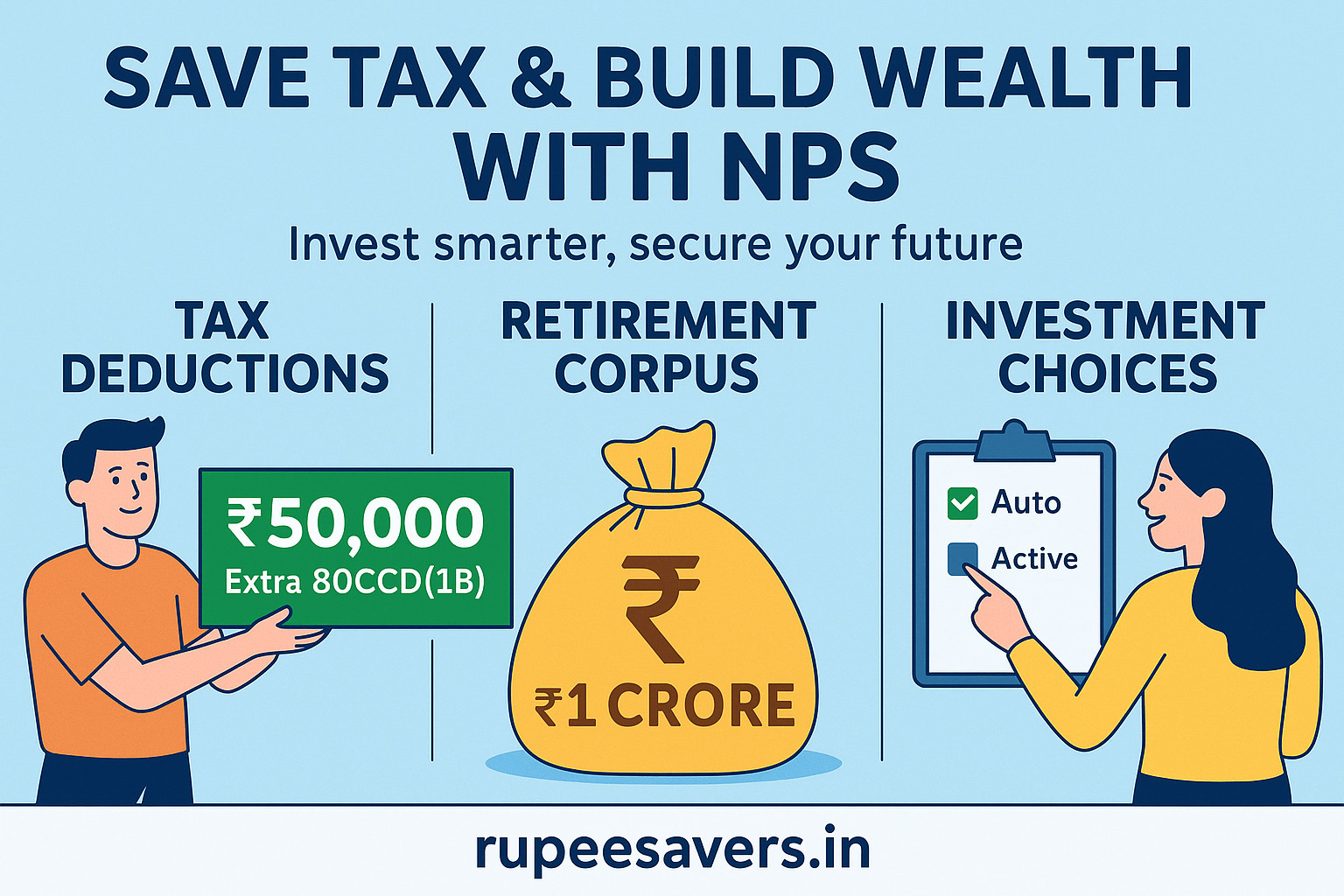You’ve Probably Heard of NPS… But Are You Using It Smartly? 💭
Most salaried Indians have heard of the National Pension System (NPS).
But here’s the truth:
Only a small percentage use it right — and fewer truly understand how powerful it is.
Done right, NPS can:
- 🛡️ Slash your tax bill by ₹15,600 every year
- 💰 Build a ₹1 Cr retirement corpus over time
- 💼 Cost you less than your monthly food delivery bill
This post shows you how to use NPS smartly — with real-life examples, tips, myth-busting, asset mix ideas, and a free calculator.

🧠 What is NPS? A Quick Refresher
NPS is a government-backed retirement scheme where you invest regularly and get a pension/corpus after age 60.
✅ Open to all citizens (18–70 years)
✅ Regulated by PFRDA
✅ You choose your asset mix
✅ Contributions are locked till 60 (with exceptions)
🎯 Who Should Use NPS?
- Salaried Indians earning ₹7L–₹20L/year
- Anyone maxing out 80C
- People who want a low-cost, tax-saving retirement tool
- Those who need help sticking to long-term goals
💰 Case Study: How Raj Used NPS to Save Tax & Build ₹1 Cr
Meet Raj, 29, earns ₹10 lakh/year in Bangalore.
His tax issue: Already maxed out 80C with EPF + ELSS
His goal: Build long-term wealth AND reduce tax
His solution: Invest ₹50,000/year in NPS (Section 80CCD(1B))
Results:
- Saves ₹15,600 every year in tax
- At 10% return, corpus grows to ₹1 Cr+ by age 60
- Zero effort after auto-debit
📦 NPS Tax Benefits – The Real Deal
✅ Section 80CCD(1B) – Extra ₹50,000 deduction
- Over and above 80C (₹1.5L limit)
- Saves up to ₹15,600 in tax per year
- Works under the old regime
✅ Section 80CCD(2) – Employer Contribution
- Up to 10% of basic salary
- Not counted in 80C limit
- Best if your company matches contributions
📊 NPS Tax + Wealth Calculator
| Input | Value |
|---|---|
| Age when starting | 29 |
| Yearly contribution | ₹50,000 |
| Expected return (p.a.) | 10% |
| Years until age 60 | 31 |
| Final Corpus | ₹96.3 lakh |
| Tax Saved per year | ₹15,600 |
| Total tax saved (31 yrs) | ₹4.8 lakh |
💡 Imagine building ₹1 Cr corpus + saving ₹5L in tax — just by investing ₹4K/month.
🔍 NPS vs PPF vs ELSS: Which One’s Better?
| Feature | NPS | PPF | ELSS |
|---|---|---|---|
| Tax Benefit | ₹50K extra (80CCD) | Under 80C only | Under 80C only |
| Lock-in | Till age 60 | 15 years | 3 years |
| Returns (avg) | 8%–11% | 7%–8% | 10%–14% |
| Equity Exposure | ✅ Yes | ❌ No | ✅ Yes |
| Risk Level | Medium | Low | Medium-High |
💡 Pro tip: Use all 3 together. NPS = long-term base. ELSS = growth. PPF = safety.
⚙️ NPS Asset Allocation Options
When you open your NPS account, you pick one of these modes:
🔹 Auto Choice
NPS auto-adjusts your exposure based on age
- Aggressive: More equity early
- Moderate: Balanced
- Conservative: More debt
🔹 Active Choice
You control:
- Up to 75% in equity (E)
- Rest in corporate (C) and govt bonds (G)
📑 Sample NPS Asset Mix Based on Risk Appetite
| Risk Type | Equity (E) | Corporate Debt (C) | Govt Securities (G) |
|---|---|---|---|
| Aggressive | 75% | 15% | 10% |
| Balanced | 50% | 30% | 20% |
| Conservative | 25% | 35% | 40% |
💡 You can change the allocation 2 times/year
💡 You can switch between auto & active anytime
✅ Step-by-Step: How to Open Your NPS Account
Step 1: Visit enps.nsdl.com
Step 2: Click on “National Pension System” → Register
Step 3: Enter Aadhaar/PAN, verify with OTP
Step 4: Choose Tier I account (tax benefit)
Step 5: Pick Pension Fund Manager (e.g., ICICI, HDFC, SBI)
Step 6: Choose Auto or Active asset allocation
Step 7: Upload photo, signature, and pay ₹500+
Done! You get a PRAN number + login.
📦 Myth vs Fact: Let’s Clear the Air
| Myth | Fact |
|---|---|
| “NPS is locked forever” | Partial withdrawals allowed for health, education, etc. |
| “Returns are too low” | Equity options deliver 10%+ long-term |
| “It’s only for retirement” | It’s also a great tax-saving tool now |
| “Too complicated to manage” | Auto mode = zero headache |
🔑 Key Benefits of NPS (Why You Should Care)
- ✅ ₹50,000 extra tax deduction (over 80C)
- ✅ Low-cost fund structure (under 0.1%)
- ✅ Equity + debt in one account
- ✅ Employer match (if offered)
- ✅ Auto-adjusting asset mix
- ✅ Built-in retirement discipline
- ✅ Compounds into ₹1 Cr+ long-term
💡 Pro Tips to Maximize NPS
- Set up auto-debit monthly (₹4,167 = ₹50K/year)
- Use Active choice if you understand equity/debt
- Pick fund managers like HDFC, ICICI, SBI
- Track performance once a year
- Combine NPS with ELSS + PPF for tax planning
❓ FAQs: NPS for Salaried Indians
Q1. Can I exit NPS before 60?
Yes.
After 3 years, you can withdraw up to 25% for specific needs (health, marriage, etc.).
Full exit before 60 has some conditions but is possible.
Q2. What’s Tier II in NPS?
Tier II = no tax benefits
Used for extra savings (like mutual funds)
You can skip this if you’re focused only on tax + retirement.
Q3. Is NPS safe?
Yes — regulated by PFRDA, managed by top fund houses, and offers diversified investment.
Q4. How do I know which fund manager is best?
Compare past performance on CRA portals or ETMoney, Groww.
Most salaried users pick SBI or ICICI for stability.
Q5. Can I use NPS + PPF + ELSS together?
Yes, and you should!
They complement each other beautifully:
- NPS: Long-term
- PPF: Safe
- ELSS: Fast growth
📥 Download Your Free NPS Tax-Saving + Wealth Planner (Excel + PDF)
Want to know:
- How much tax you’ll save with NPS?
- What your corpus will be at 60?
- Which asset mix suits you best?
We’ve built a calculator and cheat sheet just for you.
✅ Plug in your age and investment
✅ Get final corpus + tax savings
✅ Choose the right asset strategy
✅ Works for Tier I account holders
👉 [Download NPS Tax Planner + Asset Mix (FREE Excel & PDF)]
(Insert CTA button or link)
Final Thought: NPS Is Not Just for Retirement. It’s for Freedom. 🧘♂️
Don’t look at NPS as a “boring” pension thing.
Look at it as:
✅ A legal way to slash taxes
✅ A powerful wealth creator
✅ A system that forces you to think long-term
Start today with just ₹4,000/month.
Your future self will thank you — big time.


